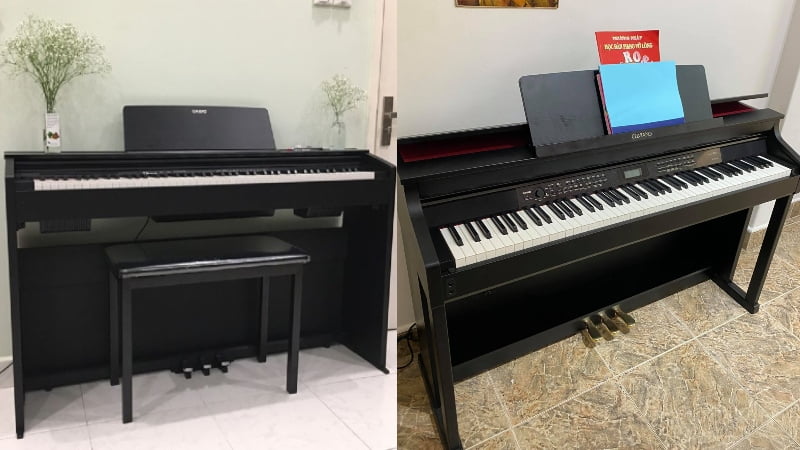Learn which Casio digital console piano is the best pick in this comprehensive Casio PX-870 vs Casio AP-650 review.
There’s no doubt in my mind that Casio is one of the best brands for affordable digital pianos that offer a lot of bang for your buck. A great example of this is the PX-870, which is slightly above the $1,000 price point but offers features that you usually find in more expensive pianos.
This is why I was quite surprised to learn that the brand also released the Casio AP-650, which is a much more expensive piano. And while it costs much more than the Casio PX-870, it comes with a wide range of features that justify the price.
As most pianists will tell you, buying a digital piano isn’t just about getting the most expensive model available. If you want to get the best digital piano for your needs, it’s best to take a deep dive into its features.
And when I did this with the PX-870 and the AP-650, I found that the AP-650 is a bit more versatile. That’s why the AP-650 ended up winning this Casio PX-870 vs AP-650 comparison.
But as you’ll soon see, the Casio PX-870 puts up a really good fight. And for some pianists, it might actually be the better pick. Keep reading to learn which piano is best suited to your needs.
Casio PX-870 vs Casio AP-650: Comparison Chart




Last update on 2025-07-04 / Affiliate links / Images from Amazon Product Advertising API
Casio PX-870 vs Casio AP-650: A Head-to-Head Comparison
I chose to keep this comparison as simple and objective as possible. That’s why I compared these pianos based on three characteristics – their tone, the way they feel, and the polyphony. In my opinion, these are the most important aspects of any digital piano and the ones you need to pay the closest attention to when buying one for yourself.
Based on these comparison points, the Casio AP-650 comes out on top with a score of 3-2. While the Casio PX-870 was right beside the AP-650 in every category, it fell short because of its limited sound library, which can’t compare to the AP-650’s wide sound library with many voices.
Tone
The winner: Casio AP-650
When comparing the tone of these two pianos, I must admit that they sounded pretty similar. Both pianos share a tone generator, so this wasn’t a big surprise. And while they regarded tone quality, the Casio PX-870 fell short with tone quantity.
As a fairly affordable digital piano, the PX-870 has a limited set of tones. On the flip side, the AP-650 has a massive sound library, which is why it won the comparison.
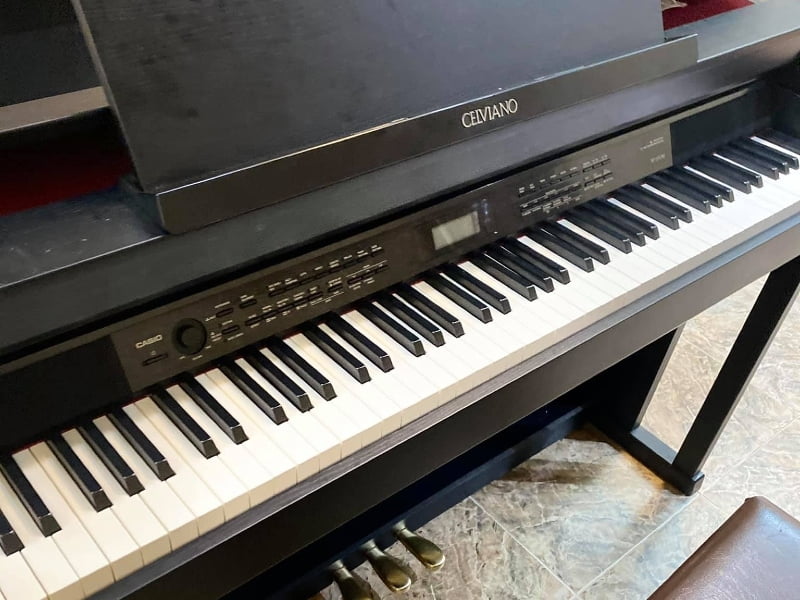
+Tone Generation
Both of these pianos utilize the Multi-Dimensional Morphin AiR generator. This is a Casio tone engine that does a great job of mimicking the sound of an acoustic piano. And one of the ways it does this is by reproducing the entire life cycle of a piano’s sound wave.
Piano sounds travel through the air uniquely, so pianos produce a signature sound. So, this tone engine tries to replicate the way the sound travels when it’s initially played and how the sound slowly fades away. This provides a great layer of realism, especially when you let notes ring out.
Additionally, this tone generator is great at replicating the volume differences when you play a piano key. So, you can add a lot of emotion to a song by choosing to play loudly or softly, and these pianos will replicate how that translates on an acoustic piano.
I had no issues with the way either of these pianos sounded. While this tone engine isn’t the most realistic option on the market, it captures many subtle details that other tone engines don’t.
So, if you’re particular about sound quality, either of these pianos will serve you well.
+Sound Library
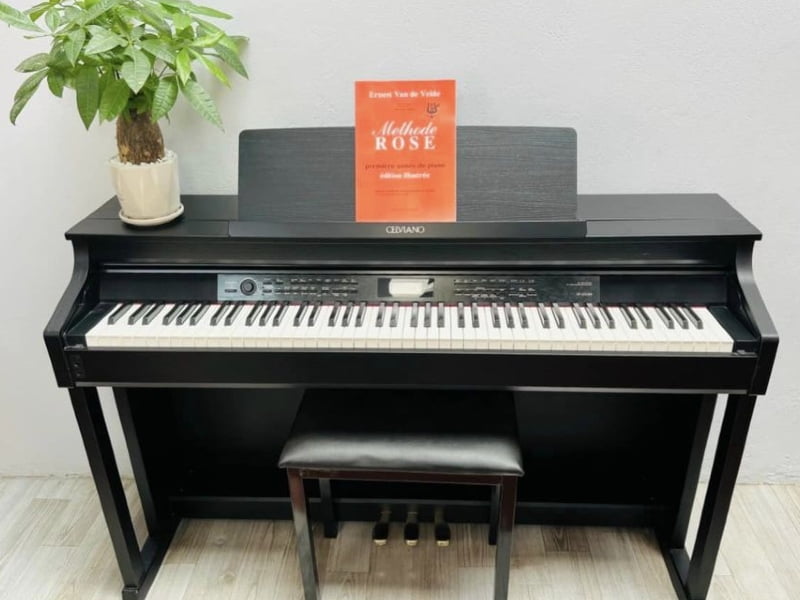
The main reason the Casio AP-650 won this comparison was its sound library. This piano comes with 250 different voices. Aside from the essentials like piano, electric piano, harpsichord, organ, and strings, it comes with unique tones like guitar, bass, sound effects, and even drums.
This is great if you’re looking for a versatile digital piano as you can play just about any genre of music with the AP-650. Whether you’re in a jazz, rock, hip-hop, or even experimental music band, you’ll find the right voices on the AP-650.
On the flip side, the PX-870 only comes with the essentials. This makes it great for beginners and pianists that don’t require that much variety in their tones. However, there’s no doubt that this is a limited sound library that could be much larger.
Feel
The winner: Tie
The next feature I considered was how the pianos felt. It’s important for a digital piano to have a realistic feel that mimics an acoustic piano. And between these two models, there was no clear winner. Both pianos come with great hammer action and realistic key textures, so I gave both models a point for this category.
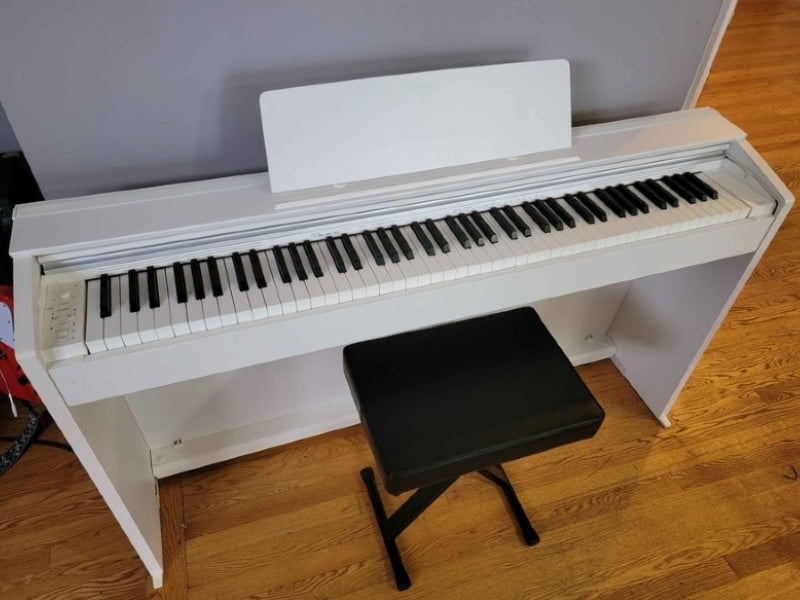
+Hammer Action
Both of these pianos come with Tri-Scaled Hammer Action II, which is one of their main selling points. This is one of the best hammer action systems Casio has to offer and it provides a very realistic feel that’s just like a real acoustic piano.
The reason for this is the graded weight on the keys. Acoustic pianos don’t have a uniform weight on the keys, and these Casio pianos aim to capture these discrepancies. This provides for a great playing experience and is one of the reasons why I love both of these pianos.
On top of that, I noticed a realistic delay between when I hit the key and when I heard the sound. If you don’t pay close attention, this is a feature you can miss. However, this is another one of the subtle details that Casio considered when building these pianos that make them feel more realistic.
Additionally, both pianos have textured black and white keys. While they aren’t made of real wood, the coating on the keys makes them feel like real wooden keys. So, if you want to ensure that you get a digital piano that feels like an acoustic piano, both of these models perform really well.
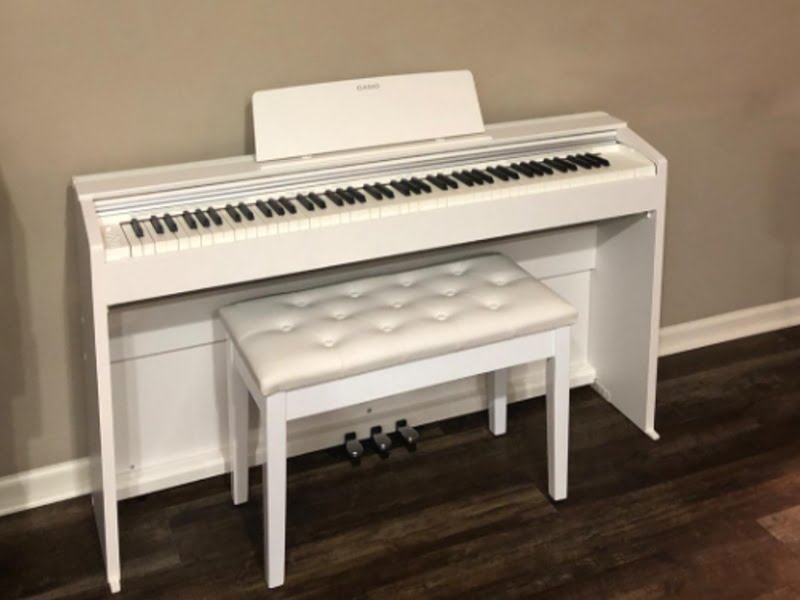
Polyphony
The winner: Tie
The last feature I considered was the polyphony. The more polyphony on a digital piano, the more notes you can play simultaneously.
And with both of these models, you get 256-note polyphony. It honestly doesn’t get much better than that in this price range, especially since 256-note polyphony is usually reserved for more expensive pianos.
The high polyphony allows you to play all the piano keys simultaneously. This comes in handy when you’re playing with the sustain pedal on, as it allows the notes to ring out for much longer, producing a more natural sound.
Nowadays, polyphony isn’t as big of a deal because more and more pianos come with high polyphony without busting the bank. However, it’s still nice to know that both of these pianos come with relatively high polyphony.
Casio PX-870 vs Casio AP-650: The Similarities
There are quite a few similarities between these two pianos. To start, they are both console digital pianos. So, they are big, bulky, and designed to stay in one place. If you’re looking for a digital piano that feels closest to an acoustic piano, this is the right option for you.
These pianos also share a tone engine and hammer action. And while the hammer action and tone from these pianos is great, it would have been nice to see a more premium set up on the AP-650, considering that it’s the more expensive model.
In fact, the only difference between these two pianos is that the AP-650 comes with more voices. Aside from that, these pianos generally look, feel, and sound the same. So, if you don’t need a wide variety of voices, you might actually get more value for the money with the PX-870.
Quick Rundown of the Casio PX-870
- TRUE PIANO FEEL & EXPRESSION – 88-key Tri-Sensor II Scaled Hammer Action delivers authentic touch with simulated ebony and ivory textures, offering remarkable feel and superior dynamic control.
- IMMERSIVE GRAND PIANO SOUND – The AiR Sound Source delivers rich detail with advanced damper and string resonance, key-off simulation, and mechanical sounds—recreating the full depth of a concert grand.
- POWERFUL 40W SOUND SYSTEM – 4-speaker Sound Projection system fills your space with rich, immersive sound, plus Headphone Mode for quiet practice.
- The Tri-Sensor Scaled Hammer Action II keyboard has an incredible feel and captures the dynamics of a performance with unparalleled speed and accuracy
- BUILT FOR LEARNING – Duet Mode, dual headphone jacks, 60 built-in songs, 2-track MIDI recorder, and Concert Play with orchestral backing tracks.
Last update on 2025-07-03 / Affiliate links / Images from Amazon Product Advertising API
Quick Rundown of the Casio AP-650
Last update on 2025-07-04 / Affiliate links / Images from Amazon Product Advertising API
Product Video
Related Articles to Casio Px 870
- Casio PX-870 vs PX-850: Finding the Best Privia Piano
- Casio PX-870 vs AP-470: What Makes the AP-470 Different?
- Casio PX-870 Vs AP-270: Which Console Digital Piano Should You Get?
- Casio PX-870 Vs Yamaha YDP-163: Which Digital Piano Is The Better Option?
- Casio PX-870 Vs Yamaha YDP-143: A Look At Two Top Digital Console Pianos
- Casio PX-870 Vs Yamaha P-125: Should You Get A Portable Or Console Digital Piano?
- Casio PX-870 Vs Kawai KDP-110: The Best Digital Pianos In The Price Range?
- Casio PX-870 Vs Roland F140R: Which Is The Better Piano?
- Casio PX-870 Vs Roland FP-30: Which Piano Should You Choose?
- Casio PX-870 Vs 860: A Battle Of Two Privia Pianos
- Casio PX-870 Vs Roland RP102: Which Is The Better Console Digital Piano For Beginners?
- Casio PX-870 Vs PX-780: Which Casio Model Is Best For You?
- Casio PX-870 Vs Yamaha YDP-164: Which Is The Better Choice For Beginners?
- Casio PX-870 Vs Yamaha YDP-144: Which Is The Better Console Digital Piano?
- Casio PX-770 Vs 870: Which Casio Console Digital Piano Is Better?
References:
- Casio PX-870: https://www.casio-intl.com/asia/en/emi/products/px870/spec/
- Casio AP-650: https://www.casio.com/intl/electronic-musical-instruments/product.AP-650MBK/
Lulacruza is an electronic folk duo operating at the junction of the hypermodern and the ancient. Our music weaves together hypnotic female singing, South American folk instruments and electronic processing, while channeling pulsating waves from the source of creation.
Lalucruza is also a community where you can connect with other music lovers to collaborate, exchange ideas and share knowledge. A platform for who wants to learns the basics of playing piano, guitar, drum masters’ technique, etc.. is the premise of our website.
